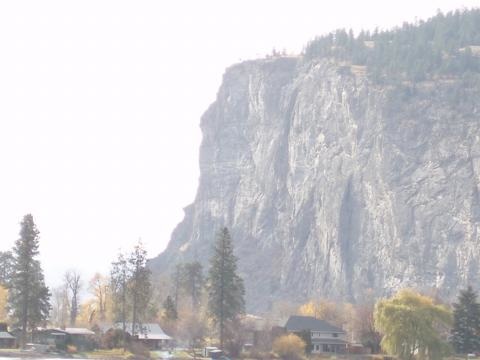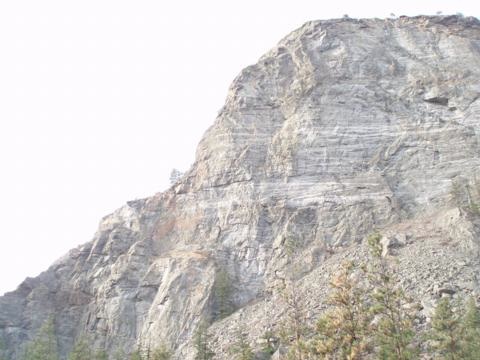McIntyre Bluff EarthCache
-
Difficulty:
-

-
Terrain:
-

Size:  (not chosen)
(not chosen)
Please note Use of geocaching.com services is subject to the terms and conditions
in our disclaimer.
McIntyre Bluff exposes a high wall of granitic gneiss, shot through
with thin layers of quartz and other mineral veins. The rock is
known as the Vaseux Formation and probably belongs to the Shuswap
Metamorphic Complex of Precambrian age. This cliff is the steepest
and most dramatic in the Okanagan Valley, and the valley itself is
the narrowest and most constricted in the Okanagan at this. Other
geologic dramas have been identified at this site. The rocks have
been subjected to major tectonic (mountain building) events that
have served to fold the rocks into great overturned fold structures
at least 10 kilometers wide. The main structure is called the
McIntyre Bluff Fold. It is a huge recumbent to isoclinal syncline
with a northeasterly trending fold axis. It is also referred to as
a nappe. Although three periods of mountain building and folding
are recognized by geologists John V. Ross and James S. Christie of
the University of British Columbia, the main fold structure dates
to at least Permian time, over 270 million years ago.
How was this landform carved out of this mountainous terrain?
According to Dr. Hugh Nasmith, who studied the glacial history of
the valley in the early 1960's, deep intensive erosion of the
Okanagan was first accomplished by one or more rapidly flowing
valley glaciers. It is very likely that several periods of valley
glacier erosion operated to repeatedly gouge out a path down the
valley during the last one or two million years. It is known from
other parts of the valley that the bedrock floor has been eroded so
deeply that today it is far below sea level at an elevation of -640
meters (-2100 feet) below Okanagan Lake, for example. Overall, in
fact, the Okanagan Valley has witnessed the removal of nearly three
kilometers of its rock by glaciers, which is almost twice as deep
as that eroded from Arizona's Grand Canyon!
Some geologists suspect large ice-sheets that completely overtopped
the mountains in this region could have similarly eroded valleys
such as the Okanagan. There were several of these ice-sheets that
enveloped the Okanagan, and likely all were in excess of three
kilometers thick. Consider the extreme power at the base of such a
glacier along pre-existing valleys where forces would be
concentrated. Some combination of these processes in any event
managed to slice through at least 500 meters of the hard
metamorphic rocks at McIntyre Bluff, like a knife through cheese!
Awesome!
A strange geologic conundrum shrouds McIntyre Bluff. Despite being
deeply incised, the rocks at high elevation on McIntyre Bluff
record ice flow indicators of a really old ice sheet that flowed
southeasterly towards the United States. These ice-flow indicators
have been truncated by the more recent gouging out of the bluff,
leaving geologists with additional mysteries of the wonders of
Mother Nature. (Information from www.geoscapes.ca)
The bluffs were also the site of a battle between the Shuswap and
the Okanagan Indians.
The posted coordinates that you to a safe public parking area to
view the McIntyre Bluff.


Questions:
1. Email (do not post) the cache owner the elevation at the posted
coordinates.
2. Email (do not post) the cache owner the estimated height of the
bluff.
3. Post a photo of yourself with GPS in hand or if you are alone, a
photo of your GPS at the EarthCache site.
Additional Hints
(No hints available.)